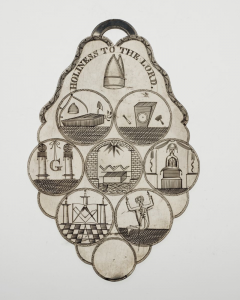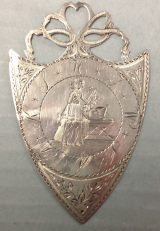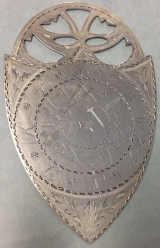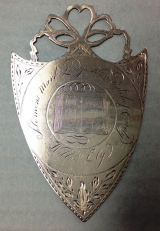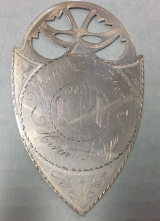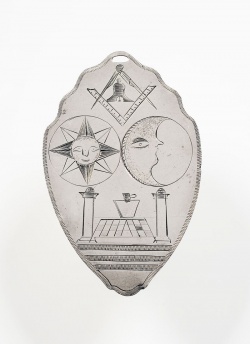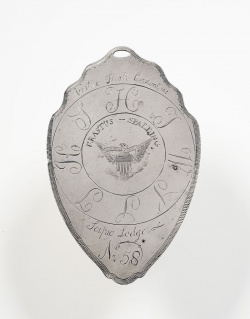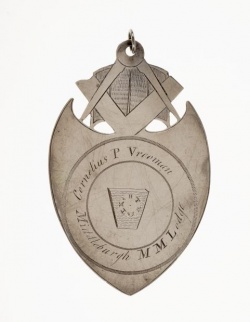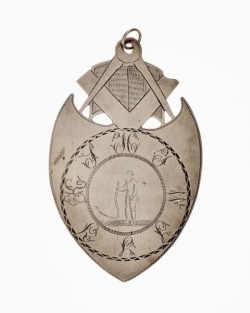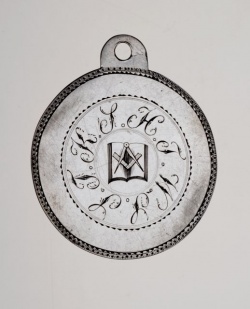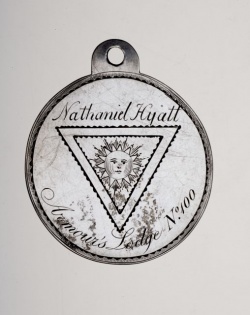En: Mark Medals
James Higgins’ Mark Medal
Source: Scottish Rite Masonic Museum & Library
A year ago the Scottish Rite Masonic Museum and Library was lucky enough to receive a give of a collection of chapter pennies and badges, mostly dating from the early 1900s. Mixed in with the comparatively modern tokens was an engraved silver mark medal that belonged to James Higgins, made in the 1810s or 1820s (below, at left).
As regular blog readers know, these individually commissioned badges can be fascinating.This one sparked our interest because of its intriguing shape and similarity to another in the collection: a gilded and engraved crafted for Henry Brayman, a member of David’s Royal Arch Chapter (at left).
Both of these medals were cut in an interesting lobed form. One side is engraved with the owner’s name and chapter, the other bears the Royal Arch motto “Holiness to the Lord,” a mitre and eight circles (both below, at left). Within each circle the engraver illustrated selections of Masonic symbols or scenes that relate to the Mark Master degree. For example, the circle on the upper right contains images of a keystone, chisel and mallet—all symbols of the Mark Master degree.The circle at the lower left encloses three candles, an open Bible, a square and compasses—the lesser and greater lights of the lodge. Comparison of the symbols and scenes engraved within the circles points to a common inspiration for these vignettes, although we don’t yet know what it is. Each medal also features an integrated hanging loop at its top, as well as similarly styled script letters in the mnemonic “HTWSSTKS” separated by simple flowers, and a trailing vine embellishing the top edge of the medal by the loop. Together, the similarities between the two medals suggest they may be the work of the same engraver.
The man who owned the gilded medal, Henry Brayman, belonged to David’s Chapter No. 34 and St. Paul’s Lodge in Auburn, New York. He may have been the Henry Brayman (1791-1853) who lived in Aurelius and later Buffalo, New York. James Higgins owned the silver medal. He is likely the James Higgins (1766-1827) who was born in Connecticut but later lived in Hamilton, New York, where he worked as a cabinetmaker, hotel keeper and tanner. He was a member of Hamilton Lodge, No. 121, as well as Cyrus Royal Arch Chapter No. 50 of Eaton, New York. Brayman selected a personal mark of a square and awl and had these the symbols engraved on his medal along with his name. James Higgins never had his mark incised on his badge, for reasons we can only speculate about. Hopefully ongoing research will uncover more about these expertly crafted and interestingly decorated medals. If you have any insights to share, please let us know in a comment.
Many thanks to Tom Savini, Director, Chancellor Robert R. Livingston Masonic Library, Grand Lodge of New York.
Mark Medals from Dutchess County, New York
As always, we are excited about some of our recent acquisitions! Just a few weeks ago, the Scottish Rite Masonic Museum & Library was able to add two beautifully engraved mark medals to our growing collection. These two medals are each interesting on their own. They also prompted intriguing questions when viewed side by side.
In previous posts we have discussed other mark medals in the collection. These engraved badges feature a specially selected symbol—often related to Freemasonry or the owner’s profession—sometimes along with the owner’s name and his lodge’s name and location. These two shield-shaped mark medals are embellished with intricate pierced tops. These carefully made decorative elements were designed to allow the owner to wear his badge around his neck, suspended from a ribbon.
Each of these medals bears an owner’s name and Masonic lodge. William Ely (dates unknown) belonged to Solomon’s Mark Lodge in Poughkeepsie, New York and commissioned the medal with top pierced to look like a ribbon tied in a bow (see at left). Ely chose a complicated symbol, or mark, for himself: a young woman holding a vine in her left hand and a set of scales in her right. She stands next to a table or counter, decorated with a square and compasses. A mortar and pestle and a bottle sit on it, possibly suggesting apothecary work. The other medal belonged to John Dutcher (dates unknown), a member of Hiram Lodge No. 27 in Amenia, New York. His mark, surrounded by the mnemonic associated with the mark degree and a circle enclosing 15 different Masonic symbols, was a top hat and what looks to be a gavel (see image below at right)—symbols often associated with the office of lodge master.
Ely’s lodge, Solomon’s Lodge of Poughkeepsie, first chartered in 1771, had several numbers over the years it met—1, 56 (the number on this medal and used by the lodge from 1797-1800), 5 and 6. Members are thought to have established a mark lodge, called Solomon’s Mark Lodge, during the late 1700s. Hiram Lodge No. 27—first founded in 1793 as Payne Lodge, called Hiram Lodge after 1797—received a dispensation for a mark lodge in 1810. The Grand Chapter approved the charter for Hiram Mark Lodge No. 65 in 1811.
The Ely and the Dutcher medals are both shield-shaped with different pierced elements. A close look at the sides of the two medals that bear Ely’s and Dutcher’s names show like symbols—an open Bible with a corner of a page folded back—engraved in a similar style (see images at left and below). The image is embellished with the same flourishes at the top and bottom of the open volume. This and other similarities shared by the medals suggests a question: did the same craftsman design and engrave these medals? Hopefully, with further research, we will learn more about these medals' owners and makers. If you have any ideas or insights, be sure to leave a comment below!
References:
Catalog notes, Minute Book, Solomon’s Lodge No. 1, Poughkeepsie, New York (1771-1852), Chancellor Robert R Livingston Masonic Library of the Grand Lodge of New York.
Compiled by Gary L. Heinmiller, Craft Freemasonry in Dutchess County, New York, (Onondaga & Oswego Masonic Districts Historical Societies, March 2010).
Proceedings of the Grand Chapter of Royal Arch Masons of the State of New York, Volume 1. 1798-1853. (Buffalo, New York: Grand Chapter, 1871).
Erastus Spalding's Mark Medal
Every now and then, a researcher’s inquiry will inspire us to take a closer look at an object in the collection—recently this mark medal made for Erastus Spalding (1775-1830) of Scipio, New York. It was added to the collection of the Scottish Rite Masonic Museum & Library a few years ago.
On his medal, formed out of thin sheet silver in the shape of a plumb bob, Spalding commissioned a craftsman to engrave text and symbols. On one side of the medal (shown on the left), Spalding had several Masonic symbols along with a mallet and keystone, emblems related to the mark degree, engraved. On the other side of the medal (shown on the right), for his mark--the symbol he chose to represent himself--Spalding selected elements taken from the Great Seal of the United States. The seal, officially adopted in 1782, featured an eagle supporting striped shield. In one talon the eagle grasps an olive branch, representing peace; in the other the eagle grips arrows, to signify war. From the eagle's beak a banner decorated with the motto E Pluribus Unum (out of many, one) flies. Spalding also directed that a Masonic motto, “Virtue Shall Cement Us,” be incised on the medal, as well as the name of his lodge, Scipio Lodge No. 58.
Born in Connecticut, Spalding first came to Scipio with his parents and siblings in the late 1780s or early 1790s. Spalding’s father, Oliver (1739-1795) served in the Revolutionary War. Grants of land made to former Revolutionary War soliders may have drawn his family to the area. Erastus and some of his brothers seem to have owned land in Scipio after their father’s death (you can see their names near plot 138 on this map). In developing their new community, area men established Scipio Lodge No. 58. Chartered in 1797, the lodge counted Spalding among its early members. He served on a committee that organized the construction of a new lodge building after an 1805 fire and as Junior Warden in 1807. By the early 1810s, Spalding and his family left Scipio. They eventually lived in Charlotte, Rochester and, later, Lockport, New York.
Intriguingly, Scipio Masons did not establish their Royal Arch Chapter--Aurora Chapter No. 64--until 1819, several years after Erastus Spalding had moved. Further research may uncover information about when and where Spalding took the mark degree. Regardless, the text and symbols Spalding had engraved on his medal point to the pride he felt as a Mason and as a citizen of the new United States.
Photographs:
Mark Medal, 1800-1820. New York. Museum Purchase, 2011.021. Photos by David Bohl. References:
A Short History: Scipio Lodge No. 110 (Ann Arbor, Michigan: Edward's Brothers, Inc.), 1940.
Samuel J. Spalding, Spalding Memorial: A Genealogical History of Edward Spalding of Massachusetts Bay and His Descendants, (Boston: Alfred Medge & Son, Printers), 1872.
Occupation-Related Symbols on Mark Medals
Some time in the early 1800s, Cornelius P. Vrooman (1784-ca. 1821), a member of Middleburgh Mark Lodge, Middleburgh, New York, commissioned this silver shield-shaped medal. It is a recent addition to the Scottish Rite Masonic Museum and Library's collection. The maker incorporated important Masonic symbols into the form of Vrooman’s medal--the square, compasses and open Bible at the top of the shield. Engraved details like the print on the Bible pages and the outline of the compasses’ legs help delineate the symbols. On one side of the medal (illustrated to the left), the craftsman detailed Vrooman’s name and the name of his lodge as well as a keystone marked with the mnemonic associated with the Mark Master degree, HTWSTTKS. On the other side (illustrated below), within the border of a circle, the engraver incised the mnemonic in ornamental script. The circle contains Vrooman’s mark, a man with a scythe.
As noted in previous posts, the emblem selected by the owner of a mark jewel represented something meaningful to him. Mark Masons chose different kinds of emblems, from patriotic and Masonic symbols, to initials or family crests. In addition, many Mark Master Masons decided on representations of their occupation or profession as their personal symbol. Vrooman’s emblem appears to be one such, the man and a scythe likely denoting a farmer. If an anecdote retold in a 1870s gazetteer can be believed, Vrooman was indeed a farmer. In a description of the Vrooman family, the gazetteer's author noted that the four Vrooman brothers “were remarkable for their strength.” As an example, the author related that Cornelius “was accustomed to carry one or two bags…on his shoulders, to favor his horse, when going to Albany with a load of wheat.”
Another example of an occupation-related mark can be found in the record for Rev. Alpheus Harding (1780- 1869), whose mark of a lamb and cross spoke to his job as a religious leader. This mark is noted in the mark book kept for King Hiram Royal Arch Chapter of Greenwich, Massachusetts. (You can read previous posts about this beautifully illustrated record and its illustrator.) Other examples of symbols connoting professions appear in the late 1700s and early 1800s records of Washington Royal Arch Chapter of Middletown, Connecticut. Members of a mark lodge associated with the chapter often dictated a motto to go with their symbols, leaving a clue as to what their choice of mark represented to them. For example, William Hall (dates unknown), recorded a knife as his mark and his motto as “amputation,” suggesting he might have been a surgeon. Charles Magill (dates unknown) selected a brig as his mark and, for his motto, “navigation.” His fellow member, Noadiah Hubbard, Jr. (b. 1765), accompanied the motto “husbandry” with a plough for a mark. Another member, recorded in the 1820s, claimed a trowel as his mark along with the motto, “the implement of my profession.” Taken together these occupational marks offer an intriguing glimpse into the professional landscape of early 1800s mark lodges.
References:
James R. Case, August W. Von Hagen and Oswald H. Johnson, Early Records of Washington Chapter (6) Royal Arch Masons, of Middletown, Connecticut, Reproduced by Xerography on the 175th Anniversary (Hartford, Connecticut: Bond Press, Inc.), 1958.
Hamilton Child, Gazetteer and Business Directory of Schoharie County, New York, for 1872-1873. (Syracuse, New York: Hamilton Child), 1872, p. 115.
Photo credits:
Mark Medal, 1807-1821. Probably New York. Museum Purchase, 2013.054.3. Photos by David Bohl.
Nathaniel Hyatt's Mark Medal
As regular readers of the Scottish Rite Masonic Museum and Library blog know, we love to talk about new acquisitions. Recently we were lucky to add another intriguing mark medal to our collection, this one likely made for Nathaniel Hyatt (1781-1873) of New Castle, New York. You can read previous posts discussing mark medals crafted for Frederick Phile, Ezra Bennet and Ezekiel Bascom.
Hyatt’s medal is a plain circle, about two inches in diameter. A hole punched in a sturdy tab at the top of the medal likely accommodated a loose ring so the silver disk could be suspended from a ribbon. On both sides of the medal, simple engraved patterns decorate the outer edge. On one side, pictured to the left, the mnemonic HTWSSTKS, engraved in script letters, surrounds Hyatt’s personally selected mark, a square and compasses on top of an open Bible. The other side of the disk, illustrated below at right, bears Hyatt’s name, the name of a Masonic lodge--Armour’s Lodge No. 100--and a sun with a face enclosed by a delta.
Information about Armour’s Lodge No. 100 or any mark lodge associated with it, is scarce. Proceedings of the Grand Lodge of New York, note that Armour Lodge, located in Rye, New York, received a warrant in 1803. Members named their organization after one of the petitioners, Samuel Armour (dates unknown). The lodge made its last return to the Grand Lodge in 1827. In that same year, a New York City directory listed Armour Lodge as meeting in Sawpits, a village of Rye. By 1834 the lodge had forfeited its charter. (Later New York Masons revived the name for a lodge in Port Chester, Armour Lodge No. 186, founded in 1850.) Proceedings of the Grand Chapter of New York record that in 1818 members of the Armour Lodge submitted a “…petition for Armour Mark Lodge, No. 100, [which] was not proper either in form, address or recommendation, and should be returned.” From the proceedings, it does not seem that the petition was re-submitted. Although the records in the Grand Chapter Proceedings are not clear, Hyatt’s medal, bearing the name of the lodge, suggests Armour Lodge members eventually established a mark lodge.
The 1830 census lists a Nathaniel Hyatt as a resident of Rye, New York, with a family of seven children. This man likely owned the medal and is quite possibly the man listed in an online resource, Craft Masonry in Westchester and Putnam Counties, New York, as a member of Hiram Lodge No. 72 in Mount Pleasant, New York, along with his father, Abraham Hyatt (1747-1830). Abraham Hyatt signed the original petition for the lodge in 1796. Nathaniel Hyatt (son of Abraham) and his wife, Amy Van Wart Carpenter Hyatt (ca. 1786-1848) were Quakers who married and worshiped in Chappaqua, New York. Both born in New Castle, New York; they had at least nine children.
Hopefully, further research will add to our understanding of the commissioner of this medal, his Masonic participation and the lodges he belonged to. In the meantime, Hyatt’s handsome silver token offers enduring evidence of Armour Lodge No. 100 and one of its members.
Photo credits:
Mark Medal, 1803-1827. Probably New York, Museum Purchase, 2013.054.2. Photos by David Bohl.
References:
Compiled by Gary L. Heinmiller, Craft Masonry in Westchester and Putnam Counties, New York. (Onondaga & Oswego Masonic Districts Historical Societies, May 2011).
Harold W. Jack, Mark Lodges of New England. (Boston, Massachusetts: The Massachusetts Chapter of Research, 1976).
Proceedings of the Grand Chapter of Royal Arch Masons of the State of New York, Volume 1. 1798-1853. (Buffalo, New York: Grand Chapter, 1871).
Transactions of the Grand Lodge of Free and Accepted Masons of the State of New York, 1816-1827. (New York: Masonic Publishing and Furnishing Co., 1880).

![Mark Medal made for Henry Brayman, ca. 1818-ca. 1830, New York. Museum Purchase, 2008.010. Photograph by David Bohl.]]](/images/thumb/3/3f/Mark_Medals.png/240px-Mark_Medals.png)
![Mark Medal made for Henry Brayman, ca. 1818-ca. 1830, New York. Museum Purchase, 2008.010. Photograph by David Bohl.]]](/images/thumb/0/0f/BackMedal.png/240px-BackMedal.png)
